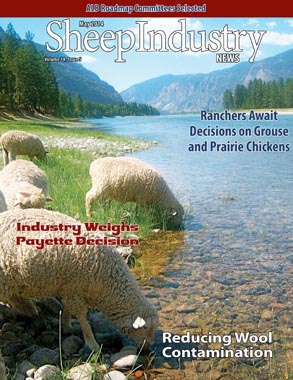Importance of Sheep Often Forgotten as Years Fly By
By Clint KrebsASI President
May is here and most of the lambs are on the ground. Shearing is winding down and after this last winter I am sure most everyone is looking forward to spring and summer.
It is the time of year when sheep fulfill their part of “our symbiotic” relationship by converting grass and sunshine into food and fiber. It is no wonder they have been part of humans lives for over 6,000 years.
As I learn more of the history about man and sheep, I am always reminded of the importance of sheep, when people were immigrating to new places of the world. Trailing sheep on the ground seems pretty straight forward, but can you imagine what it would be like to be on one of the ships in the 1600s crossing the Atlantic for 6 to 8 weeks with a couple hundred sheep on board.
I have not been able to find out how the sheep were fed and watered, or any details of their care, but it must have been pretty amazing. However, when the new settlers accomplished the ocean crossing, it was the source for the beginning sheep flocks on the east coast.
The first British colony was established at Jamestown, Virginia in 1607. However, the sheep were all eaten in the first winter. It was two years later before more sheep were brought to Virginia and, because of attacks by wolves and Indians, 40 years later there were only 3,000 sheep in the colony.
In 1657, transportation of sheep out of Virginia was forbidden.
Maryland was established in 1632 with the same Leicester long wool type sheep as Virginia. On the other hand, the Carolinas, founded in 1663, started with some of the better breeds from England. Maybe this is why we still have a wool textile industry there today.
Progress was slow because wool manufacturing was forbidden in the new colonies. All of the wool was required to be sent to the home countries for processing. Holland brought sheep to their colonies in 1625, some from the island of Texel. Sweden sent sheep into Delaware in 1638 and required the Swedish settlers to send wool home to pay for their passage.
Sheep reached Plymouth, Massachusetts in 1624, mainly the Down types – Texel, and Romney. Southdowns arrived in Rhode Island in 1648.
Massachusetts had 3,000 sheep in 1640 and they were described as “sort of coarse Leicester, but of the commonest kind.”
In the original settlements, each family kept a few sheep near their home. As the sheep numbers increased, they were co-mingled with others and grazed on common land by a hired sheepherder. Allotments of grazing rights, and the ratios of different livestock were regulated by governmental authorities.
The settlers in New England were required to have 5 or 6 sheep for every cow.
By necessity, communities worked together to control predators.
I find it fascinating that 350 years later we are still working on government regulations concerning grazing on our public lands, predator control, and issues about our employees who are herding and tending to sheep.
The original colonies would not have survived without sheep, and regulations were put in place to insure and require sheep production.
In today’s world, regulations are increased every day which often hinder sheep production. How soon we forget.


